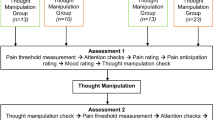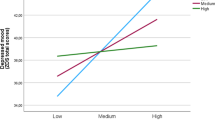Abstract
We examined whether people who tend to catastrophize about pain and who also attempt to regulate negative thoughts and feelings through suppression may represent a distinct subgroup of individuals highly susceptible to pain and distress. Ninety-seven healthy normal participants underwent a 4-min ischemic pain task followed by a 2-min recovery period. Self-reported pain and distress was recorded during the task and every 20 s during recovery. Participants completed the Pain Catastrophizing Scale and the White Bear Suppression Inventory. Repeated measures multiple regression analysis (using General Linear Model procedures) revealed significant 3-way interactions such that participants scoring high on the rumination and/or helplessness subscales of the Pain Catastrophizing Scale and who scored high on the predisposition to suppress unwanted thoughts and feelings reported the greatest pain and distress during recovery. Results suggest that pain catastrophizers who attempt to regulate their substantial pain intensity and distress with maladaptive emotion regulation strategies, such as suppression, may be especially prone to experience prolonged recovery from episodes of acute pain. Thus, emotion regulation factors may represent critical variables needed to understand the full impact of catastrophic appraisals on long-term adjustment to pain.



Similar content being viewed by others
References
Bartley, E. J., & Rhudy, J. L. (2008). The influence of pain catastrophizing on experimentally induced emotion and emotional modulation of nociception. The Journal of Pain, 9, 388–396.
Burns, J. W. (2006). Arousal of negative emotions and symptom-specific reactivity in chronic low back pain patients. Emotion, 6, 309–319.
Burns, J. W., Quartana, P., & Bruehl, S. (2008a). Anger inhibition and pain: Conceptualizations, evidence and new directions. Journal of Behavioral Medicine, 31, 259–279.
Burns, J. W., Quartana, P. J., Gilliam, W., Gray, E., Matsuura, J., Nappi, C., et al. (2008b). Effects of anger suppression on pain severity and pain behaviors among chronic pain patients: Evaluation of an ironic process model. Health Psychology, 27, 645–652.
Cioffi, D., & Holloway, J. (1993). Delayed costs of suppressed pain. Journal of Personality and Social Psychology, 64, 274–282.
Cohen, J., Cohen, P., West, S. G., & Aiken, L. S. (2003). Applied Multiple Regression/Correlation Analysis for the Behavioral Sciences (3rd ed.). New Jersey: Lawrence Erlbaum Associates, Inc. 201 p.
Crombez, G., Eccleston, C., Van den Broeck, A., Goubert, L., & Van Houdenhove, B. (2004). Hypervigilance to pain in Fibromyalgia: The mediating role of pain intensity and catastrophic thinking about pain. Clinical Journal of Pain, 20, 98–102.
Edwards, R. R., Kronfli, T., Haythornthwaite, J. A., Smith, M. T., McGuire, L., & Page, G. G. (2008). Association of catastrophizing with interleukin-6 responses to acute pain. Pain, 140, 135–144.
France, C. R., France, J. L., al’Absi, M., Ring, C., & McIntyre, D. (2002). Catastrophizing is related to pain, but not nociceptive flexion reflex threshold. Pain, 99, 459–463.
Goubert, L., Crombez, G., & Van Damme, S. (2004). The role of neuroticism, pain catastrophizing, and pain-related fear in vigilance to pain: A structural equations approach. Pain, 107, 234–241.
Gross, J. J. (1998). Antecedent- and response-focused emotion regulation: Divergent consequences for experience, expression, and physiology. Journal of Personality and Social Psychology, 74, 224–237.
Gross, J. J., & John, O. P. (2003). Individual differences in two emotion regulation processes: Implications for affect, relationships, and well-being. Journal of Personality and Social Psychology, 85, 348–362.
Gross, J. J., & Levenson, R. W. (1993). Emotional suppression: Physiology, self-report, and expressive behavior. Journal of Personality and Social Psychology, 64, 970–986.
Gross, J. J., & Levenson, R. W. (1997). Hiding feelings: The acute effects of inhibiting negative and positive emotion. Journal of Abnormal Psychology, 106, 95–103.
Maurset, A., Skoglung, L. A., Hustveit, O., Klepstad, P., & Oye, I. (1992). A new version of the ischemic tourniquet pain test. Methods and Findings in Experimental Clinical Pharmacology, 13, 643–647.
McCracken, L. M., Vowles, K. E., & Eccleston, C. (2005). Acceptance-based treatment for persons with complex, long-standing pain: A preliminary analysis of treatment outcome in comparison to a waiting phase. Behaviour Research and Therapy, 28, 271–284.
Michael, E. S., & Burns, J. W. (2004). Catastrophizing and pain sensitivity among chronic pain patients: Moderating effects of sensory and affect focus. Annals of Behavioral Medicine, 27, 185–194.
Muris, P., Meesters, C., van den Hout, A., Wessels, S., Franken, I., & Rassin, E. (2007). Personality and temperament correlates of pain catastrophizing in young adolescents. Child Psychiatry and Human Development, 38, 171–181.
Osman, A., Francisco, F. X., Gutierrez, B. A. K., Merrifield, T., & Grittmann, L. (2000). The pain catastrophizing scale: Further psychometric evaluation with adult samples. Journal of Behavioral Medicine, 23, 351–365.
Quartana, P., & Burns, J. W. (2007). The painful consequences of anger suppression. Emotion, 7, 400–414.
Severeijns, R., van den Hout, M. A., & Vlaeyen, J. W. S. (2005). The causal status of pain catastrophizing: An experimental test with healthy participants. European Journal of Pain, 9, 257–265.
Severeijns, R., van den Hout, M. A., Vlaeyen, J. W., & Picavet, H. S. (2002). Pain catastrophizing and general health status in a large dutch community sample. Pain, 99, 367–376.
Severeijns, R., Vlaeyen, J. W. S., van den Hout, M. A., & Picavet, S. J. H. (2004). Pain catastrophizing is associated with health indices in musculoskeletal pain: A cross-sectional study in the dutch community. Health Psychology, 23, 49–57.
Severeijns, R. M., Vlaeyen, J. W. S., van den Hout, M. A., & Weber, W. E. J. (2001). Pain catastrophizing predicts pain intensity, disability and psychological distress independent of level of physical impairment. The Clinical Journal of Pain, 17, 165–172.
Smeets, R. J. E. M., Vlaeyen, J. W. S., Kester, A. D. M., & Knottnerus, J. A. (2006). Reduction of pain catastrophizing mediates the outcome of both physical and cognitive-behavioral treatment in chronic low back pain. The Journal of Pain, 74, 261–271.
Sullivan, M. J. L., Bishop, S. R., & Pivik, J. (1995). The pain catastrophizing scale: Development and validation. Psychological Assessment, 7, 524–532.
Sullivan, M. J. L., Thorn, B., Haythornthwaite, J. A., Keefe, F., Martin, M., Bradley, L. A., et al. (2001). Theoretical perspectives on the relation between catastrophizing and pain. The Clinical Journal of Pain, 58, 52–64.
Sulllivan, M. J. L., Rouse, D., Bishop, S., & Johnston, S. (1997). Thought suppression, catastrophizing and pain. Cognitive Therapy and Research, 21, 555–568.
Tan, G., Jensen, M. P., Robinson-Whelen, S., Thornby, J. I., & Monga, T. N. (2001). Coping with chronic pain: A comparison of two measures. Pain, 90, 127–133.
Thorn, B. E., & Boothby, J. L. (2002). Targeted treatment of catastrophizing for the management of chronic pain. Cognitive and Behavioral Practice, 9, 127–138.
Turner, J. A., Dworkin, S. F., Mancl, L., Huggins, K. H., & Truelove, E. L. (2001). The roles of beliefs, catastrophizing, and coping in the functioning of patients with temporomandibular disorders. Pain, 92, 41–51.
Turner, J. A., Mancl, L., & Aaron, L. A. (2004). Pain-related catastrophizing: A daily process study. Pain, 110, 103–111.
Van Damme, S., Crombez, G., Bijttebier, P., Goubert, L., & van Houdenhove, B. (2002). A confirmatory factor analysis of the pain catastrophizing scale: Invariant factor structure across clinical and non-clinical populations. Pain, 96, 319–324.
Wegner, D. M., Schneider, D. J., Carter, S. R., & White, T. L. (1987). Paradoxical effects of thought suppression. Journal of Personality and Social Psychology, 53, 5–13.
Wegner, D. M., & Zanakos, S. (1994). Chronic thought suppression. Journal of Personality, 62, 615–640.
Whitehead, W. E., Crowell, M. D., Heller, B. R., et al. (1994). Modeling and reinforcement of the sick role during childhood predicts adult illness behavior. Psychosomatic Medicine, 56, 541–550.
Acknowledgments
This research was supported in part by Grant MH071260 from the National Institute of Mental Health.
Author information
Authors and Affiliations
Corresponding author
Rights and permissions
About this article
Cite this article
Gilliam, W., Burns, J.W., Quartana, P. et al. Interactive effects of catastrophizing and suppression on responses to acute pain: a test of an appraisal × emotion regulation model. J Behav Med 33, 191–199 (2010). https://doi.org/10.1007/s10865-009-9245-0
Received:
Accepted:
Published:
Issue Date:
DOI: https://doi.org/10.1007/s10865-009-9245-0




